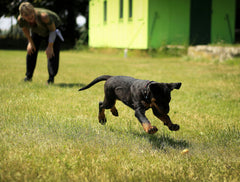
Nobody wants to be caught in a situation where you have an unpleasant encounter with a dog, but unfortunately, it can happen. In the U.S. alone, there are over 4.7 million dog bites every year. It is essential to know exactly what to do if you suffer from a dog bite and know how to prevent your dog from biting. Infection can play a significant role in a dog bite, so proper dog bite treatment needs to occur to avoid further damage. We will go over everything from training your dog correctly to dog bite antibiotics. We can only hope you never encounter this unfortunate event, but it is always good to be prepared.
Dog Bite Treatment

Despite being a ton of dog bites occurring throughout the year in the United States, only 1 out of 5 dog bites need further medical attention. Once a dog bites you, it is vital to wash the wound with soap and warm water to clean the infected area. Grab a clean cloth and gently press against the wound. This will help stop the bleeding, which will be followed by applying an antibacterial ointment. This step is essential because bacterial growth can cause an infection. Apply a clean, sterile bandage to the wound and keep an eye on the wound. If the area is not healing then call your doctor immediately because there may be an infection.
When to See a Doctor

Many dog bites can be treated at home and will heal properly with constant cleaning and time to heal. This does not mean that this is the case for everybody. If you were bit by an unfamiliar dog, seeking a Doctor to check your wound is vital. There is no way of knowing for sure if that dog is up to date on its vaccinations. If the wound will not stop bleeding and you cannot get it under control, seek medical help.
If you were bit by your dog, the bleeding has stopped, and you went through the proper procedure to treat your wound, but there is any discoloration, tenderness, or heat when you touch around the wound, a foul odor, or immense pain this could be a sign of infection. You would need to seek medical attention right away, so the infection does not spread. If your doctor determines your bite is infected, they might prescribe or use common dog bite antibiotics. Amoxicillin-clavulanate is used to fight a bacterial infection and prevent it from spreading.
Which Dogs Are Prone to Biting

There is a way to measure how strong a dog’s bite is, called a dog’s bite force. Although this could be helpful, a dog bite force is not truly an indication if a dog is aggressive. For example, a Mastiff has the strongest bite force of all the breeds at about 550 pounds, but they are anything but aggressive. It is not to say that Mastiffs don’t bite, but they are not known as an aggressive breed. The top breeds with the highest percentage of bites are Pitbulls, Mixed-breed dogs, and German Shepherds.
Reviewing these percentages should not deter you from welcoming any of these breeds into your home because it is important to remember that every dog can bite. Obedience training, proper care, and socialization all play a significant role in a dog’s temperament.
How to Train Your Dog to Not Bite

There are many reasons why a dog will bite you. When a dog feels threatened, it is their instinct to protect themselves, and the way they do that is by biting. It is essential to learn what not to do that may make a dog feel threatened. Startling a dog awake from sleeping, being too rough or aggressive with them, or their territory is being invaded whether it’s their food, puppies, or owner can all provoke a dog to bite. Training your dog not to bite needs to happen at an early age. Obedience training, properly socializing your pup, positive discipline, and knowing their demeanor and body language. Over time, you will notice when your dog starts to feel threatened, and you can take your dog out of the situation they are in to prevent any incident.
Conclusion
Dogs are meant to be friendly, loyal, and loving pets, but we cannot forget that these playmates are still animals at the end of the day. They have an innate animal instinct that they will act upon if they feel they are threatened in any way. Proper training will help combat your dog from biting in the future, but unfortunately, you cannot control other people’s dogs, so you might be met with an aggressive dog that will bite. Knowing the proper procedure for treatment can aid in recovery against infection unless the bite is extensive where a doctor is needed. Do not ever assume a dog will never bite, look for signs of agitation, and have an exit strategy before a situation escalates.




